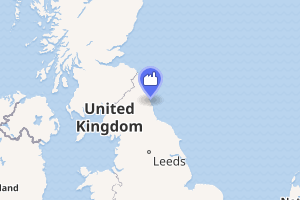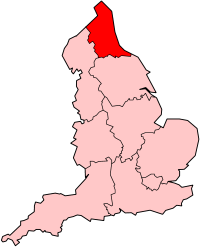Blyth Offshore Wind Farm
Blyth Offshore Wind Farm was a small coastal wind farm located 0.5 miles (0.80 km) off the coast of Blyth, Northumberland, England.
| Blyth Offshore Wind Farm | |
|---|---|
 Blyth Offshore Wind Turbines in January 2004 | |

Location of Blyth Offshore Wind Farm in Northumberland | |
| Country | England, United Kingdom |
| Location | Blyth, Northumberland |
| Coordinates | 55°08′09″N 01°29′25″W |
| Status | Decommissioned & Removed |
| Commission date | December 2000 |
| Decommission date | March 2019 |
| Construction cost | €4.6 million |
| Owner(s) | E.ON Shell Reneables NUON Border Wind |
| Operator(s) | E.ON EDF Energy |
| Wind farm | |
| Type | Offshore |
| Max. water depth | 6–11 m (20–36 ft) |
| Distance from shore | 1.6 km (1.0 mi) |
| Hub height | 62 m (203 ft) |
| Rotor diameter | 66 m (217 ft) |
| Rated wind speed | 17 m/s (38 mph) |
| Power generation | |
| Units operational | 2 x 2 MW |
| Make and model | Vestas: V66-2.0 MW |
| Nameplate capacity | 4 MW |
| External links | |
| Commons | Related media on Commons |
History
Commissioned in December 2000 as a pilot project, the project was developed by a consortium that included E.ON, Shell Renewables, NUON and Border Wind. E.ON were in charge of operating the farm.[1][2]
The project was the UK's first offshore wind farm, following the Vindeby in 1991 and Tunø in 1995, as well as being the largest offshore turbines erected in the world at the time.[3] It helped pave the way for more than 600 bigger offshore turbines installed in British waters since then.[4]
The wind farm was scheduled for decommissioning (as required by authorities) in 2019. One turbine went for spare parts, while the other was re-erected as a training facility in Blyth harbour.[4]
There are plans to add a 100 MW test facility of 15 turbines at Blyth and nearby Newbiggin-by-the-Sea, supported by a government grant. The site would be administered by The National Renewable Energy Centre (Narec), based in Blyth.[5] The test facility received planning consent in November 2013.[6] It is planned with the Vestas V164-8MW and 66 kV cables.[7]
The turbines have been decommissioned and replaced with five turbines further off shore.[8]
Design and specification
The farm consisted of two Vestas 2 MW turbines.[3]
The gravity based foundation (GBF) was the concrete foundation for the wind turbines that was produced on land, in a dry dock. The self-floating GBF was floated to its destination and then immersed by ballasting it with water and sand. The GBF sat firmly on the sea bed and the wind turbine is then installed on this foundation. These foundations were 30 metres in diameter and had a 60 metre long shaft. [9]
References
- "Archived copy". Archived from the original on 2 November 2012. Retrieved 11 December 2015.CS1 maint: archived copy as title (link)
- http://www.power-technology.com/projects/blyth/%5B%5D
- Deign, Jason (25 March 2019). "UK's Blyth Retirement Offers an Early View of Offshore Wind Decommissioning". www.greentechmedia.com. Retrieved 25 March 2019.
- Black, David (5 April 2012). "£300m Blyth offshore wind farm test facility planned by Narec". Newcastle Upon Tyne: The Journal. Retrieved 8 August 2012.
- Blyth offshore wind farm test site approved, BBC News, 8 November 2013
- "Blyth Offshore Demonstrator Project - Array 2 - 4C Offshore". Retrieved 11 October 2016.
- "Most powerful turbines installed at Blyth offshore demonstrator wind farm – low carbon electricity to power around 34,000 homes". EDF. Retrieved 6 January 2020.
- "Gravity Base Foundation for Blyth". BAM infra. Retrieved 27 November 2019.
